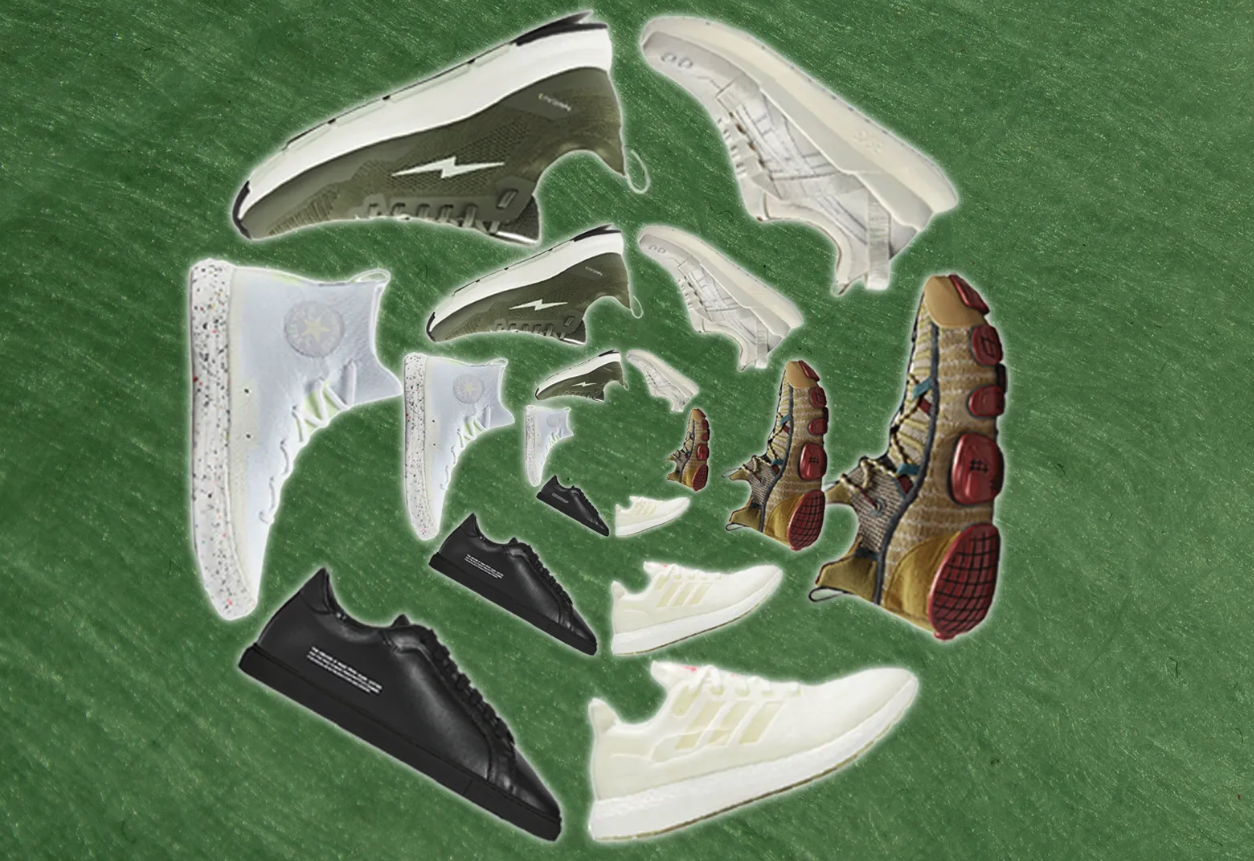Why Is It So Hard to Make a Sustainable Sneaker?
From carbon-neutral wool to freaky fruit leathers and emission-eating outsoles, it feels like every footwear brand is fighting to build the world’s most sustainable shoes. Are any of their solutions actually better?
Written By: Oliver. Franklin-Wallis
These days it feels like buying sustainable sneakers requires a master's degree in environmental science. Did you want those in vegan leather or fruit leather? Chrome-free or vegetable-tanned? Prefer your outsoles made of recycled plastic, corn foam, or algae, perhaps? (Hell, why even buy sneaks, when you could rent them?) It can feel exhausting when all you want is a new pair of shoes.
But there’s a reason behind footwear’s sustainable makeover. With so many of us (rightly) freaking out about the climate crisis—and increasingly aware of fashion's impact—designers are racing to improve their eco-credentials. That’s particularly true when it comes to shoes, because of their outsized environmental, well, footprint. According to a 2013 study by researchers at MIT university, the average pair of sneakers generates around 13kg of CO2 emissions (a stat made crazier when you consider that a pair of size 12 Converse weighs around 0.78kg.) By one estimate, sneaker manufacturing generates about 1.4 per cent of all global CO2 emissions. “In 2019, 66.6 million pairs of shoes were being manufactured every single day,” says Tansy Hoskins, author of Footwork: What Your Shoes Are Doing to the World. “Which adds up to a total of 24.3 billion pairs every year. When you make anything at that scale, it’s going to have a huge environmental impact.”
Unlike, say, your favorite merino sweater, sneakers are complicated and material-intensive objects, not so much one piece as several—leathers, cottons, plastics, foams—stuck together, often with toxic glues. The result is that sneakers are some of the least environmentally-friendly products that we wear. “And at the waste end, experts estimate that 90 per cent of that 24.3 billion pairs are not being recycled, so [they’re] being burned or put into landfill,” says Hoskins.
Which is why sneaker brands have been noisily launching greener alternatives over the last few years. Shoes like Adidas’ “fully recyclable” Futurecraft.loop series, or Nike’s grungecore ISPA line, which features detachable soles. We’ve seen shoes made from factory scraps (Converse Renew), corn-based materials (Hylo) and even a fully biodegradable “regenerative sneaker” (the Degenerate by Unless Collective). Puma just announced the Re:Suede, its first biodegradable suede sneak. Meanwhile, materials have expanded from the once radical vegan leather to include a whole bowl’s worth of fruit and vegetable-based alternatives, from apple to grape, pineapple, banana, even cactus. You only need to look at the continuing rise of brands like Veja—whose vegan leather sneakers have become ubiquitous among climate-conscious suburbanites—to see why bigger brands are worried.
But amid all these competing claims, it can be hard to know which of these new products are actually better for the planet, versus which just sound better. “Vegan leather” and “fruit leathers” are just plastics—for a fact that led the Portuguese government to ban the term in 2022.
“The problem with most of the alternative leathers is that they still have some form of polyurethane [in],” says Amanda Parkes, chief innovation officer at Pangaia, an eco-clothing brand beloved by very famous guys like Harry Styles. “This is a coating that basically allows them to stay together as a solid, and have any level of durability.” (Pangaia is now moving from plant leathers to Mirum, a rubber-based material that has no plastic content.)
Plus, while evidence shows that vegan leathers have a lower carbon footprint than animal leathers, they can also shed microplastics as they wear. The same is true of shoes made from recycled materials . While that recycled plastic has come from somewhere, it almost certainly wasn’t another pair of shoes, and rather things like old drinks bottles. And while recycling does lower a shoe’s environmental footprint, the same microplastics problem persists. (“The one that makes me the most crazy is when people use recycled plastic bottles to make bathing suits,” says Parkes. “You’re taking something that was relatively stable, breaking it up, and putting it back into the ocean in a very vulnerable state as bathing suit fibres. It’s the worst possible use of recycled plastic.”)
Most of the early attempts at making a more sustainable sneaker focused on end-of-life—what you do with the shoes when they’re done. But more recently, sneaker brands are starting to focus on something more fundamental: the climate impact of the shoe itself.
In 2021, Adidas partnered with Allbirds to announce the Futurecraft.footprint, a limited run shoe that, at the time, claimed the lowest carbon footprint for a sneaker ever: 2.94kg CO2 equivalent per pair. In 2022, Asics one-upped them with the Gel-Lyte II CM:1.95kg CO2. Then, in June, Allbirds went even further and announced the “M0.0NSHOT”, trumpeted as “the world’s first carbon zero shoes”—that is, their Co2 footprint is, at least according to the marketing, zero.
How can a shoe be carbon neutral? According to Allbirds, it’s in the materials. “When we think about carbon footprint, there's five lifecycle phases. There's materials, manufacturing, transportation, use and end of life,” says Aileen Lurch, senior sustainability manager for Allbirds. “The three highest would be materials, manufacturing, and transportation.” For the M0.0NSHOT, Allbirds worked with a specific farm, Lake Hawea Station in New Zealand, to develop a “carbon negative” wool upper; the farm offsets the emissions produced in rearing its sheep and producing wool by planting new trees, rotating crops, and other carbon-sequestering activities.
The wool had an interesting side effect: “All of a sudden, if I have carbon negative materials as a designer, the [carbon footprint] score will be lower if I use more,” Allbirds co-founder Tim Brown says. The result was the MO.ONSHOT’s futuristic sock-like wool construction. Not everyone is a fan; sneakerheads on Reddit responded to the design by calling it “weird” and “goofy as hell.” Love it or hate it, there’s no doubting that it looks like the future. “You want to design something that provokes a reaction and discussion,” Lewis says.
The rest of the M0.0NSHOT was equally designed with zero emissions in mind: the outsole is made from “carbon negative” sugar-cane-based EVA, while the plastic detailing is made using captured methane, a particularly nasty greenhouse gas. And Allbirds has pledged to ship the shoes using sustainable methods, including electric trucks where available, and by working with Goodshipping, a company that offsets shipping emissions using plant-based biofuels. (Side note: although Allbirds claims its figures have been verified by Toitū Envirocare, a New Zealand based carbon-measurement company, GQ is unable to independently verify its figures.)
Allbirds says its M0.0NSHOT won’t be available until Spring 2024, and even then in limited quantities. And while some are skeptical about the company’s figures and the reality of its zero-carbon claims, Allbirds has also published its methodology in a so-called 'Recipe Book’, and is urging other footwear brands to do the same. “I can’t talk about it right now, but there’s a couple of things in the works that are just incredible,” Brown says.
Allbirds isn’t the only sneaker company chasing negative emissions. Last autumn, On Running revealed the Cloudprime, a prototype shoe that features a sole made from captured carbon emissions. Its new midsole material, CleanCloud, is manufactured using carbon monoxide emitted by steel mills; On’s partners use that captured gas to produce EVA, which gives the sole its signature bounce. “We are taking carbon monoxide directly from source before it gets into the atmosphere and becomes carbon dioxide,” says Nils Altrogge, who runs On’s Innovation Portfolio. While the brand won’t share numbers, the result is a “significant reduction in carbon”, Altrogge says. Right now, the Cloudprime is just a concept; the brand has only produced five pairs. “But that’s not our goal—our goal was to show it’s possible, to win partners so we can scale,” says Altrogge. “And now we’re in the middle of scale-up discussions.”
Carbon-eating midsoles aren’t the only alternative solution On is chasing. The running brand has also introduced Cyclon, an apparel rental service; rather than buy a pair of its Cloudneo running shoes, you can rent them (for $30 a month). When you’re done running (or need a new pair) the brand will then recycle them itself.
Cyclon was conceived due to a simple observation: that while many brands now sell recyclable sneakers, very few actually get recycled. In fact, On estimates that industry wide, the figure is as low as 10 percent. “We have to get the product back,” Altrogge says. “A subscription model is one of the answers. And it really works.” (While On won’t release its return rates, a representative of the brand told me their rate was substantially higher than average.)
This idea of circular fashion—returning products to be recycled into new products—sounds good in theory, but it’s not without its critics. For one thing, shipping all that material back and forth creates its own emissions problems. “When we're talking about what happens at end of life, the answer can't be [individual] brands, collecting it, shipping it all over the world, breaking it down into little pieces,” Allbirds’ Aileen Lurch says. “This needs large scale infrastructure. It has to be a bigger scale solution.”
The reality is that it’s complicated; like the rest of the economy, reducing fashion’s climate impact isn’t going to be a quick fix. Despite the industry’s best efforts, it hasn’t always gone in the right direction. Although Nike, for example, has made admirable strides in many areas such as renewables and cutting waste, it reported that its own carbon emissions from manufacturing have actually increased 43 per cent since 2015. Its use of carbon-intensive leather, in particular, has increased significantly, with the brand blaming “consumer preference” for leather-intensive retro styles. (I’m sure Dunk Day has nothing to do with it.) Adidas, similarly, actually increased its emissions between 2021 and 2022, blaming sales growth and post-pandemic returns to the office. Both have work to do to hit their climate goals.
For Allbirds’ Tim Brown, it’s the bigger picture we should be focused on, rather than obsessing over the minutiae of which plastic-or-plant leather is better or nitpicking brands’ use of controversial carbon offsets. “There's these really large companies with infinitely more resources that aren't held to the same standards,” Brown says. “I think we need to set a criteria, so there’s a level playing field… that’s partly to do with government legislation. I think we need to rally around exactly what words mean, and what the standards equate to. Otherwise it’s just unfair on the people that are trying to do this properly.”
And if you’re just after a new pair of sneakers? Well it’s complicated, but a few general rules: old-school plant-based fibers like canvas will always have a significantly lower carbon footprint than leather, and don’t shed microplastics. (If it’s organic, the CO2 footprint will be even lower.) Foams made from plant-based feedstocks like corn, similarly, tend to have a lower footprint—even if they’re not always as biodegradable as you’d hope—and cut back on the use of fossil fuels. As Brown says: “Nature’s making a comeback.”
But if you’re really interested in cutting your own climate impact, the bigger question is whether you need that new pair of sneaks at all. It’s never been easier to buy second-hand—eBay, Vinted, and other apps are awash with pre-loved and never-opened sneaks. Or maybe, just maybe, you could eke out your current pair a little longer. After all, “the easiest thing to do to reduce carbon footprint by 50 percent,” says Altrogge “is using something double the time.”
This story originally appeared on British GQ with the title “The fraught, frenzied, maybe impossible race to build a sustainable sneaker”

